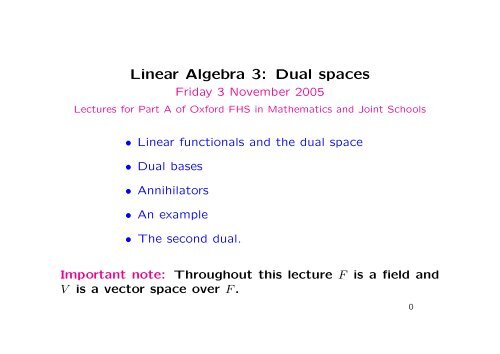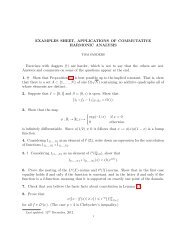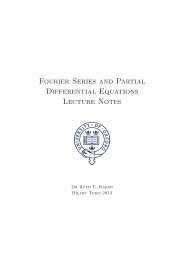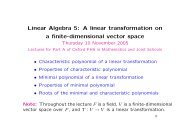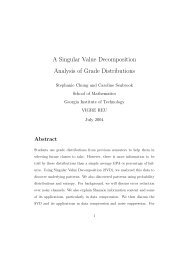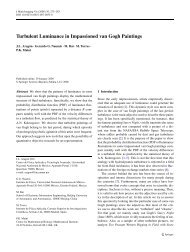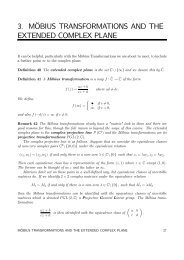Linear Algebra 3: Dual spaces
Linear Algebra 3: Dual spaces
Linear Algebra 3: Dual spaces
You also want an ePaper? Increase the reach of your titles
YUMPU automatically turns print PDFs into web optimized ePapers that Google loves.
<strong>Linear</strong> <strong>Algebra</strong> 3: <strong>Dual</strong> <strong>spaces</strong><br />
Friday 3 November 2005<br />
Lectures for Part A of Oxford FHS in Mathematics and Joint Schools<br />
• <strong>Linear</strong> functionals and the dual space<br />
• <strong>Dual</strong> bases<br />
• Annihilators<br />
• An example<br />
• The second dual.<br />
Important note: Throughout this lecture F is a field and<br />
V is a vector space over F .<br />
0
<strong>Linear</strong> functionals<br />
Definition: a linear functional on V is a function f : V → F such<br />
that<br />
f(α1v1 + α2v2) = α1f(v1) + α2f(v2)<br />
for all α1, α2 ∈ F and all v1, v2 ∈ V .<br />
Note: thus a linear functional is a linear transformation V → F ,<br />
where F is construed as a 1-dimensional vector space over itself.<br />
Example: if V = F n (column vectors) and y is a 1×n row vector<br />
then the map v ↦→ y v is a linear functional on V .<br />
1
<strong>Dual</strong> <strong>spaces</strong><br />
Definition: The dual space V ′ of V is defined as follows:<br />
Set := set of linear functionals on V<br />
0 := zero function [v ↦→ 0 for all v ∈ V ]<br />
(f1 + f2)(v) := f1(v) + f2(v) [pointwise addition]<br />
(λf)(v) := λf(v) [pointwise multiplication by scalars]<br />
Note: Check that the vector space axioms are satisfied.<br />
Note: Sometimes V ′ is written V ∗ or Hom(V, F ) or Hom F (V, F ).<br />
2
<strong>Dual</strong> basis, I<br />
Theorem: Suppose that V is finite-dimensional. For every basis<br />
v1, v2, . . . , vn of V there is a basis f1, f2, . . . , fn of V ′ such that<br />
<br />
1 if i = j ,<br />
fi(vj) =<br />
0 if i = j .<br />
In particular, dimV ′ = dimV .<br />
Proof.<br />
3
<strong>Dual</strong> basis, II<br />
Note: The basis f1, f2, . . . , fn is known as the dual basis of<br />
v1, v2, . . . , vn. Clearly, it is unique.<br />
Example: If V = F n (n×1 column vectors) then we may identify<br />
V ′ with the space of 1 × n row vectors. The canonical basis<br />
e1, e2, . . . , en then has dual basis e ′ 1 , e′ 2 , . . . , e′ n .<br />
4
Annihilators<br />
Definition: For a subset U of V the annihilator is defined by<br />
U ◦ := {f ∈ V ′ | f(u) = 0 for all u ∈ U} .<br />
Note: For any subset U the annihilator U ◦ is a subspace. It is<br />
{f ∈ V ′ | U ⊆ Kerf}.<br />
Theorem. Suppose that V is finite-dimensional and U is a subspace.<br />
Then<br />
Proof.<br />
dimU + dimU ◦ = dimV .<br />
5
A worked example<br />
Part of an old Schools question: Let V be a finite-dimensional<br />
vector space over a field F . Show that if U1, U2 are sub<strong>spaces</strong><br />
then (U1 + U2) ◦ = U ◦ 1 ∩ U ◦ 2 and (U1 ∩ U2) ◦ = U ◦ 1 + U ◦ 2 .<br />
Response.<br />
6
The second dual<br />
Theorem. Define Φ : V → V ′′ by (Φv)(f) := f(v) for all v ∈ V<br />
and all f ∈ V ′ . Then Φ is linear and one–one [injective]. If V is<br />
finite-dimensional then Φ is an isomorphism.<br />
Proof.<br />
7


